The global elastic laminate market is valued at USD 3,742 million in 2025 and is set to reach USD 6,893.4 million by 2035, growing at a CAGR of 6.3%. The market stands at the forefront of a transformative decade that promises to redefine flexible material innovation and comfort engineering excellence across hygiene, medical, apparel, and industrial sectors. The market's journey from USD 3,742 million in 2025 to USD 6,893.4 million by 2035 represents substantial growth, demonstrating the accelerating adoption of stretchable composite materials and sophisticated elastic bonding systems across disposable diaper manufacturing, adult incontinence products, surgical drape production, and athletic wear applications.
According to FMI’s Packaging Sustainability Index, a trusted dataset referenced in circular economy assessments, the first half of the decade (2025-2030) will witness the market climbing from USD 3,742 million to approximately USD 4,926 million, adding USD 1,184 million in value, which constitutes 38% of the total forecast growth period. This phase will be characterized by the rapid adoption of breathable laminate systems, driven by increasing demand for soft-touch materials and enhanced stretchability requirements worldwide. Superior moisture management capabilities and skin-friendly properties will become standard expectations rather than premium options.
The latter half (2030-2035) will witness sustained growth from USD 4,926 million to USD 6,893.4 million, representing an addition of USD 1,965 million or 62% of the decade's expansion. This period will be defined by mass market penetration of specialized elastic laminate systems, integration with comprehensive hygiene product platforms, and seamless compatibility with existing manufacturing infrastructure. The market trajectory signals fundamental shifts in how hygiene product manufacturers and medical device companies approach flexible material solutions, with participants positioned to benefit from sustained demand across multiple application segments.
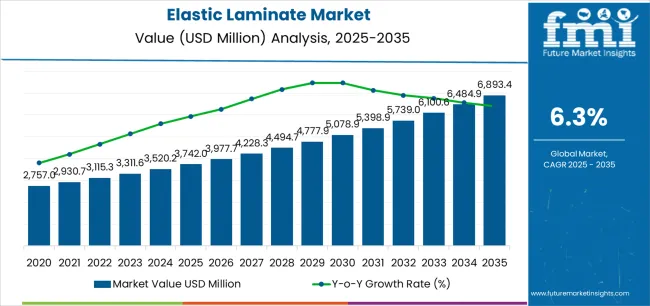
The elastic laminate market demonstrates distinct growth phases with varying market characteristics and competitive dynamics. Between 2025 and 2030, the market progresses through its breathable material adoption phase, expanding from USD 3,742 million to USD 4,926 million with steady annual increments averaging 5.7% growth. This period showcases the transition from standard elastic films to advanced systems with enhanced breathability and integrated moisture control becoming mainstream features.
The 2025-2030 phase adds USD 1,184 million to market value, representing 38% of total decade expansion. Market maturation factors include standardization of laminate specifications, declining material costs for specialty polymers, and increasing manufacturer awareness of elastic laminate benefits reaching 75-80% effectiveness in hygiene applications. Competitive landscape evolution during this period features established manufacturers like Tredegar Corporation and Schweitzer-Mauduit International expanding their product portfolios while new entrants focus on specialized bio-based solutions and enhanced comfort technology.
From 2030 to 2035, market dynamics shift toward advanced functionality and multi-sector deployment, with growth accelerating from USD 4,926 million to USD 6,893.4 million, adding USD 1,965 million or 62% of total expansion. This phase transition logic centers on universal elastic laminate systems, integration with automated converting equipment, and deployment across diverse application scenarios, becoming standard rather than specialized material formats. The competitive environment matures with focus shifting from basic elasticity to comprehensive comfort performance and compatibility with high-speed manufacturing operations.
At-a-Glance Metrics
| Metric | Value |
|---|---|
| Market Value (2025) | USD 3,742 million |
| Market Forecast (2035) | USD 6,891 million |
| Growth Rate | 6.30% CAGR |
| Leading Material Type | Polyethylene-based |
| Primary Application | Hygiene Products Segment |
The market demonstrates strong fundamentals with polyethylene-based systems capturing a dominant share through superior stretchability and cost-effective manufacturing capabilities. Hygiene products applications drive primary demand, supported by increasing disposable income levels and infant care product requirements. Geographic expansion remains concentrated in developed markets with established hygiene product infrastructure, while emerging economies show accelerating adoption rates driven by urbanization trends and rising awareness of personal hygiene.
Market expansion rests on three fundamental shifts driving adoption across hygiene and medical sectors. 1. Hygiene product evolution creates compelling advantages through elastic laminate systems that provide exceptional comfort with enhanced fit, enabling manufacturers to deliver superior wearing experience while maintaining product performance and justifying investment over standard non-elastic materials. 2. Medical device modernization accelerates as healthcare facilities worldwide seek flexible barrier materials that deliver infection control directly to surgical environments, enabling patient protection that aligns with safety protocols and minimizes healthcare-associated infection risks. 3. Consumer preference drives adoption from premium product segments requiring comfort enhancement solutions that maximize wearer satisfaction while maintaining discretion during daily activities and extended wear scenarios.
Growth faces headwinds from raw material price volatility that differs across polymer supply chains regarding feedstock availability and production costs, potentially limiting profit margins in cost-sensitive application categories. Manufacturing complexity also persists regarding lamination process control and bonding technology that may increase quality assurance requirements in markets with demanding performance standards.
The elastic laminate market represents a compelling intersection of flexible material innovation, comfort engineering, and breathability management. With robust growth projected from USD 3,742 million in 2025 to USD 6,891 million by 2035 at a 6.30% CAGR, this market is driven by increasing hygiene awareness trends, medical device modernization requirements, and consumer demand for comfortable disposable formats.
The market's expansion reflects a fundamental shift in how hygiene product manufacturers and apparel companies approach flexible material infrastructure. Strong growth opportunities exist across diverse applications, from diaper production requiring exceptional elasticity to medical drapes demanding sterile barrier solutions. Geographic expansion is particularly pronounced in Asia-Pacific markets, led by China (7.2% CAGR) and India (7% CAGR), while established markets in North America and Europe drive innovation and specialized segment development.
The dominance of polyethylene-based systems and hygiene products applications underscores the importance of proven stretchability technology and breathability in driving adoption. Material cost optimization and processing complexity remain key challenges, creating opportunities for companies that can deliver reliable performance while maintaining operational efficiency.
Primary Classification: The market segments by material type into polyethylene-based, polypropylene-based, polyurethane-based, and polyester-based categories, representing the evolution from basic plastic films to advanced breathable composites for comprehensive comfort operations.
Secondary Breakdown: Application segmentation divides the market into hygiene products, medical, apparel, industrial, and others sectors, reflecting distinct requirements for elasticity, breathability, and barrier protection.
Regional Classification: Geographic distribution covers North America, Europe, Asia Pacific, Latin America, and the Middle East & Africa, with developed markets leading innovation while emerging economies show accelerating growth patterns driven by hygiene awareness programs.
The segmentation structure reveals technology progression from standard polyethylene films toward integrated multi-layer platforms with enhanced breathability and elastic capabilities, while application diversity spans from disposable diaper operations to medical device facilities requiring comprehensive barrier protection and long-term comfort solutions.
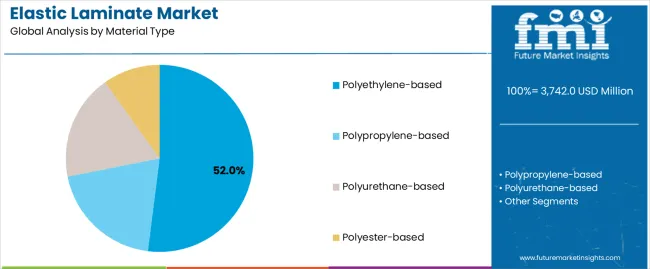
Polyethylene-based segment is estimated to account for 52% of the elastic laminate market share in 2025. The segment's leading position stems from its fundamental role as a critical component in hygiene product applications and its extensive use across multiple disposable and medical sectors. Polyethylene's dominance is attributed to its superior processing flexibility, including film formation capabilities, cost-effective manufacturing, and reliable bonding properties that make it indispensable for elastic laminate operations.
Market Position: Polyethylene-based systems command the leading position in the elastic laminate market through advanced extrusion technologies, including comprehensive thickness control, width versatility, and reliable stretching performance that enable manufacturers to deploy elastic solutions across diverse application environments.
Value Drivers: The segment benefits from converter preference for proven polymer materials that provide exceptional elasticity without requiring specialized processing equipment. Cost-effective manufacturing processes enable deployment in diaper production, incontinence products, and medical applications where stretchability performance and affordability represent critical selection requirements.
Competitive Advantages: Polyethylene-based systems differentiate through excellent elastic recovery, proven durability characteristics, and compatibility with standard lamination systems that enhance comfort capabilities while maintaining economical operational profiles suitable for diverse disposable product applications.
Key market characteristics:
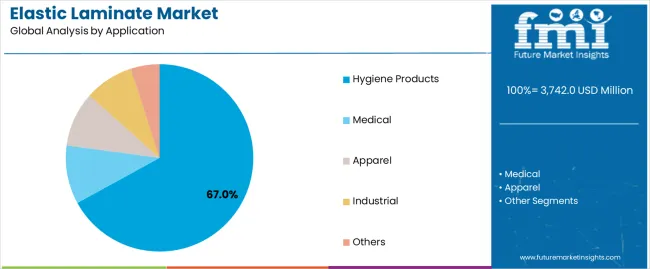
Hygiene products segment is projected to hold 67% of the elastic laminate market share in 2025. The segment's market leadership is driven by the extensive use of elastic laminates in disposable diaper production, adult incontinence products, feminine care items, and baby care applications, where elasticity serves as both a comfort feature and fit management tool. The hygiene industry's consistent investment in premium material features supports the segment's dominant position.
Market Context: Hygiene products applications dominate the market due to widespread adoption of elastic materials and increasing focus on wearer comfort, leakage prevention, and body-hugging fit that enhance product performance while maintaining discretion.
Appeal Factors: Hygiene product manufacturers prioritize stretch recovery, breathability performance, and integration with absorbent core systems that enable coordinated product design across multiple wear scenarios. The segment benefits from substantial quality requirements and consumer expectations that emphasize reliable elasticity for infant and adult care applications.
Growth Drivers: Population aging programs incorporate elastic laminates as standard components for adult incontinence products. At the same time, infant care market expansion is increasing demand for premium diaper systems that comply with safety standards and enhance baby comfort.
Market Challenges: Price sensitivity and material cost pressures may limit feature adoption in economy-tier product segments or developing market scenarios.
Application dynamics include:
Growth Accelerators: Hygiene awareness drives primary adoption as elastic laminate systems provide exceptional comfort capabilities that enable superior fit without excessive material bulk, supporting wearer satisfaction and product reliability that require flexible construction formats. Disposable income expansion accelerates market growth as consumers seek premium hygiene products that maintain comfort standards during extended wear while enhancing quality of life through reliable elastic features. Aging population increases worldwide, creating sustained demand for adult incontinence systems that complement dignity preservation and provide competitive advantages in eldercare operations.
Growth Inhibitors: Raw material volatility challenges differ across polymer supply chains regarding feedstock pricing and availability fluctuations, which may limit profitability and cost predictability in price-sensitive categories with demanding margin requirements. Processing complexity persists regarding lamination uniformity and bonding strength control that may increase manufacturing waste in high-speed production with specialized quality standards. Market fragmentation across multiple polymer types and construction formats creates compatibility concerns between different lamination methods and existing converting equipment infrastructure.
Market Evolution Patterns: Adoption accelerates in hygiene and medical sectors where comfort performance justifies material investments, with geographic concentration in developed markets transitioning toward mainstream adoption in emerging economies driven by urbanization growth and hygiene awareness campaigns. Technology development focuses on enhanced breathability, improved elastic recovery, and integration with bio-based polymers that optimize environmental profiles and manufacturing efficiency. The market could face disruption if alternative flexible materials or technology innovations significantly challenge elastic laminate advantages in hygiene applications.
The elastic laminate market demonstrates varied regional dynamics with Growth Leaders including China (7.2% CAGR) and India (7% CAGR) driving expansion through hygiene market development and disposable product adoption. Steady Performers encompass the USA (6.8% CAGR), Germany (6.1% CAGR), and Japan (5.7% CAGR), benefiting from established hygiene sectors and medical device application adoption.
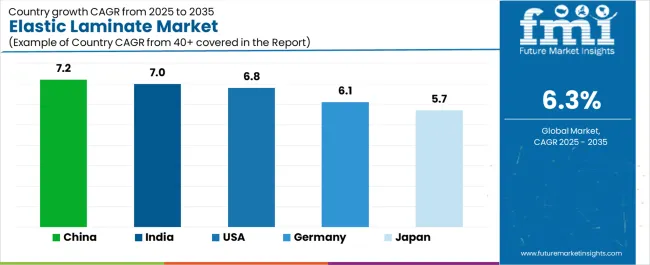
| Country | CAGR (2025-2035) |
|---|---|
| China | 7.2% |
| India | 7% |
| USA | 6.8% |
| Germany | 6.1% |
| Japan | 5.7% |
Regional synthesis reveals Asia-Pacific markets leading growth through disposable product expansion and hygiene awareness development, while European countries maintain steady expansion supported by specialized medical applications and premium hygiene product requirements. North American markets show strong growth driven by adult incontinence products and advanced medical device applications.
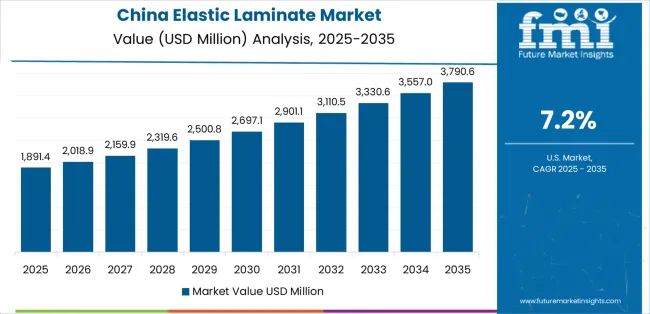
China establishes regional leadership through explosive disposable diaper expansion and comprehensive hygiene product modernization, integrating advanced elastic laminate systems as standard components in premium diaper manufacturing and adult incontinence applications. The country's 7.2% CAGR through 2035 reflects government initiatives promoting infant health and domestic hygiene industry development that mandate the use of comfortable elastic materials in personal care operations. Growth concentrates in major manufacturing regions, including Guangdong, Zhejiang, and Fujian, where hygiene facilities showcase integrated elastic laminate systems that appeal to domestic brands seeking superior comfort and international quality standards.
Chinese manufacturers are developing innovative elastic laminate solutions that combine local production advantages with international breathability specifications, including micro-embossed surfaces and advanced polymer blends.
Strategic Market Indicators:
The Indian market emphasizes disposable diaper applications, including rapid urbanization development and comprehensive hygiene awareness that increasingly incorporates elastic laminates for infant care and adult incontinence applications. The country is projected to show a 7% CAGR through 2035, driven by massive demographic shifts under government sanitation programs and commercial demand for affordable, comfortable hygiene systems. Indian hygiene facilities prioritize cost-effectiveness with elastic laminates delivering superior fit through economical material usage and efficient manufacturing capabilities.
Technology deployment channels include major diaper brands, regional hygiene manufacturers, and medical supply distributors that support high-volume usage for domestic and institutional applications.
Performance Metrics:
The USA market emphasizes advanced elastic laminate features, including innovative breathable technologies and integration with comprehensive absorbent platforms that manage moisture control, skin protection, and comfort applications through unified hygiene systems. The country is projected to show a 6.8% CAGR through 2035, driven by adult incontinence market expansion under aging population trends and commercial demand for premium, comfortable hygiene systems. American hygiene companies prioritize wearer dignity with elastic laminates delivering comprehensive comfort through soft-touch surfaces and odor control integration.
Technology deployment channels include major consumer goods companies, medical device manufacturers, and healthcare distributors that support custom development for specialized care operations.
Performance Metrics:
In Baden-Württemberg, Bavaria, and North Rhine-Westphalia, German hygiene manufacturers and medical device companies are implementing advanced elastic laminate systems to enhance product capabilities and support wearer comfort that aligns with engineering protocols and quality standards. The German market demonstrates sustained growth with a 6.1% CAGR through 2035, driven by medical innovation programs and hygiene facility investments that emphasize reliable elastic systems for healthcare and consumer applications. German hygiene facilities are prioritizing elastic laminate systems that provide exceptional breathability while maintaining compliance with safety standards and minimizing skin irritation risks, particularly important in incontinence products and medical drape operations.
Market expansion benefits from healthcare quality programs that mandate comfortable materials in medical specifications, creating sustained demand across Germany's hygiene and medical sectors, where performance and material quality represent critical requirements.
Strategic Market Indicators:
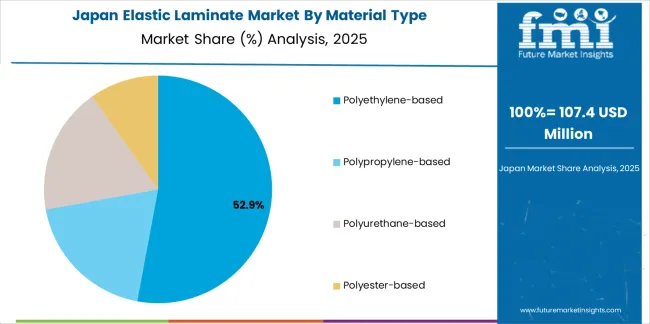
Japan's sophisticated hygiene market demonstrates meticulous elastic laminate deployment, growing at 5.7% CAGR, with documented operational excellence in diaper manufacturing and elderly care applications through integration with existing converting systems and quality assurance infrastructure. The country leverages engineering expertise in polymer science and manufacturing precision to maintain market leadership. Hygiene centers, including Tokyo, Osaka, and Nagoya, showcase advanced installations where elastic laminate systems integrate with comprehensive absorbent platforms and comfort management systems to optimize product performance and wearer satisfaction.
Japanese hygiene manufacturers prioritize material precision and comfort reliability in product development, creating demand for premium elastic laminate systems with advanced features, including nano-fiber integration and compatibility with ultra-thin diaper designs. The market benefits from established hygiene infrastructure and willingness to invest in specialized elastic technologies that provide superior comfort and regulatory compliance.
Market Intelligence Brief:
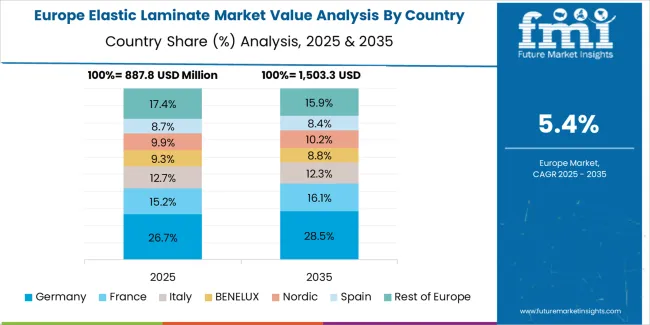
The elastic laminate market in Europe is projected to grow from USD 967 million in 2025 to USD 1,621 million by 2035, registering a CAGR of 5.3% over the forecast period. Germany is expected to maintain its leadership position with a 38.2% market share in 2025, declining slightly to 37.8% by 2035, supported by its hygiene manufacturing excellence and major production centers, including North Rhine-Westphalia and Bavaria.
France follows with a 22.6% share in 2025, projected to reach 23.1% by 2035, driven by comprehensive personal care innovation and medical device initiatives. The United Kingdom holds a 16.8% share in 2025, expected to maintain 17.2% by 2035 through established hygiene sectors and healthcare product adoption. Italy commands a 11.3% share, while Spain accounts for 8.5% in 2025. The Rest of Europe region is anticipated to gain momentum, expanding its collective share from 2.6% to 2.9% by 2035, attributed to increasing hygiene awareness in Eastern European countries and emerging Nordic medical facilities implementing elastic laminate programs.
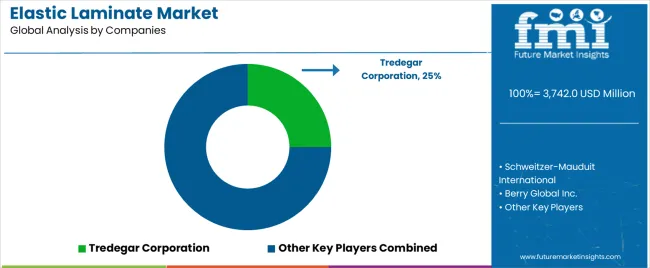
The elastic laminate market operates with moderate concentration, featuring approximately 15-22 participants, where leading companies control roughly 40-48% of the global market share through established manufacturing networks and comprehensive technical expertise capabilities. Competition emphasizes elastic recovery, breathability performance, and processing compatibility rather than price-based rivalry.
Market leaders encompass Tredegar Corporation, Schweitzer-Mauduit International, and Berry Global Inc., which maintain competitive advantages through extensive polymer expertise, global production networks, and comprehensive material specification capabilities that create customer loyalty and support technical requirements. These companies leverage decades of film manufacturing experience and ongoing polymer development investments to develop advanced elastic laminate systems with exceptional comfort and durability features.
Specialty challengers include Mitsui Chemicals Inc., Nitto Denko Corporation, and Mondi Group, which compete through specialized medical laminate focus and innovative breathable film solutions that appeal to hygiene manufacturers seeking premium comfort formats and custom functionality. These companies differentiate through material science emphasis and specialized application focus.
Market dynamics favor participants that combine reliable elastic performance with advanced breathability support, including microporous film technology and soft-touch surface capabilities. Competitive pressure intensifies as traditional film manufacturers expand into elastic laminate systems. At the same time, specialized polymer companies challenge established players through innovative bio-based solutions and cost-effective production targeting emerging hygiene segments.
| Item | Value |
|---|---|
| Quantitative Units | USD 3,742 million |
| Material Type | Polyethylene-based, Polypropylene-based, Polyurethane-based, Polyester-based |
| Application | Hygiene Products, Medical, Apparel, Industrial, Others |
| Regions Covered | North America, Europe, Asia Pacific, Latin America, Middle East & Africa |
| Countries Covered | USA, Germany, Japan, China, India, and 25+ additional countries |
| Key Companies Profiled | Tredegar Corporation, Schweitzer-Mauduit International, Berry Global Inc., Mitsui Chemicals Inc., Nitto Denko Corporation, Mondi Group |
| Additional Attributes | Dollar sales by material type and application categories, regional adoption trends across North America, Europe, and Asia-Pacific, competitive landscape with polymer manufacturers and converting specialists, hygiene manufacturer preferences for elastic recovery and breathability excellence, integration with diaper converting equipment and lamination systems, innovations in breathable film technology and bio-based materials, and development of specialized comfort solutions with enhanced stretch performance and moisture management capabilities |
The global elastic laminate market is estimated to be valued at USD 3,742.0 million in 2025.
The market size for the elastic laminate market is projected to reach USD 6,893.4 million by 2035.
The elastic laminate market is expected to grow at a 6.3% CAGR between 2025 and 2035.
The key product types in elastic laminate market are polyethylene-based, polypropylene-based, polyurethane-based and polyester-based.
In terms of application, hygiene products segment to command 67.0% share in the elastic laminate market in 2025.






Full Research Suite comprises of:
Market outlook & trends analysis
Interviews & case studies
Strategic recommendations
Vendor profiles & capabilities analysis
5-year forecasts
8 regions and 60+ country-level data splits
Market segment data splits
12 months of continuous data updates
DELIVERED AS:
PDF EXCEL ONLINE
Competitive Overview of Elastic Laminate Companies
Elastic Film Market Size and Share Forecast Outlook 2025 to 2035
Elastic Therapeutic Tape Market Growth – Trends & Forecast 2025 to 2035
Viscoelastic Dampers Market Size and Share Forecast Outlook 2025 to 2035
Laminated Busbar Market Forecast and Outlook 2025 to 2035
Laminated Tubes Market Size and Share Forecast Outlook 2025 to 2035
Laminated Glass Market Size and Share Forecast Outlook 2025 to 2035
Laminated Labels Market Size and Share Forecast Outlook 2025 to 2035
Laminated Tube Closure Market from 2025 to 2035
Market Share Breakdown of Laminated Tubes Manufacturers
U.S. Laminated Tube Market Trends & Demand Forecast 2024-2034
Laminated Woven PP Bags Market
Lid Laminates Market Size and Share Forecast Outlook 2025 to 2035
Foil Laminates Market Size and Share Forecast Outlook 2025 to 2035
Poly Laminate Capsules Market Insights - Growth & Forecast 2025 to 2035
Silk Laminated Paper Market Analysis - Size, Share, and Forecast Outlook 2025 to 2035
Market Positioning & Share in the Foil Laminates Sector
Litho Laminated Cartons Market Size and Share Forecast Outlook 2025 to 2035
Litho Laminated Packaging Market from 2025 to 2035
Cross Laminated Timber Market

Thank you!
You will receive an email from our Business Development Manager. Please be sure to check your SPAM/JUNK folder too.
Chat With
MaRIA